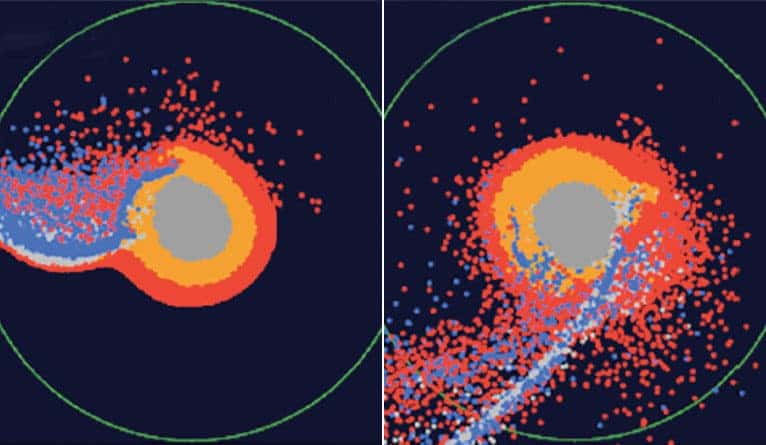
A snapshot from a recent lunar formation model. The red points indicate material from the ocean of magma while blue dots represent material from the impactor. Credit: Hosono, Karato, Makino, and Saitoh.
For decades, physicists have been trying to solve the mystery of the moon’s formation. Although several plausible models have been proposed, none stood out as particularly satisfying — until now. In a new study, researchers claim that our planet’s only natural satellite formed following the impact with a Mars-sized planet that ejected liquid magma from the surface of the early Earth into space. This magma solidified, along with a small proportion of the impactor’s material, to form the moon as we know it today.
Magma may be key to the moon’s formation
Most modern lunar formation models can at least agree on one thing — that the Earth formed around 4.5 billion years with the moon joining the system shortly after two protoplanets collided violently. The “Giant Impact Hypothesis” explains many features that we see today in the Earth and moon, such as their relative sizes and rotation rates. But it has a big shortcoming that flaws the whole model — the moon’s chemical composition.
We now know that most bodies in the solar system have unique chemical compositions, and so should the moon. However, lunar rocks brought home during the Apollo missions show that their isotopic fingerprint is almost identical to that of minerals from Earth.
In order to account for this major inconsistency, researchers have devised all sorts of alternative models. One of the most extravagant models proposed by physicists at the University of California, Davis and Harvard University claims that the ancestral collision turned early Earth into a giant planetary-sized donut made of vaporized rock called a “Synestia” (from “syn-,” “together” and “Hestia,” Greek goddess of architecture and structures). According to this theory, chunks of molten rock which were ejected into orbit following the impact formed the seed for the moon. Synestias likely don’t last long — not more than a couple hundred years — because they can’t sustain their heat, shrinking rapidly and finally collapsing into a molten planet. And while the Earth-synestia gradually shrank, vaporized silicate rock rained into the proto-moon, which explains how the moon inherited its composition from Earth. Another model suggests that the planet that collided into proto-Earth was rapidly spinning. Both models are plausible but unlikely. They simply involved too many “ifs”.
By comparison, the new model proposed by scientists at the Japan Agency for Marine-Earth Science and Technology in Yokohama and Yale University sounds closer to reality.
The researchers claim that shortly after the Earth formed, it was covered by a sea of hot magma, while the impacting object was likely made of solid material. The team performed a computer simulation showing that the impact would have heated the magma much more than solids from the impacting object. According to this simulation, the magma expands in volume and shoots into orbit to form the moon, explaining why there is much more Earth material in the lunar makeup. Even a glancing blow from the impactor would have been enough to knock more than 70% of the moon-forming debris from the magma ocean.
“In our model, about 80% of the moon is made of proto-Earth materials,” said co-author, Shun-ichiro Karato, a Yale geophysicist. “In most of the previous models, about 80% of the moon is made of the impactor. This is a big difference.”
This new model confirms previous theories about how the moon formed, without the need to propose unconventional collision conditions — but it’s not the final word on the matter either. The Japanese researchers found that the amount of debris from the impact was comparable to the current mass of the moon. Previous work, however, suggests that debris should equal about three to four times the moon’s mass. In the future, the researchers will tweak other variables such as the mass of the impactor and its rotation to see if the amount of generated debris is a better fit.
The findings appeared in the journal Nature Geoscience.









